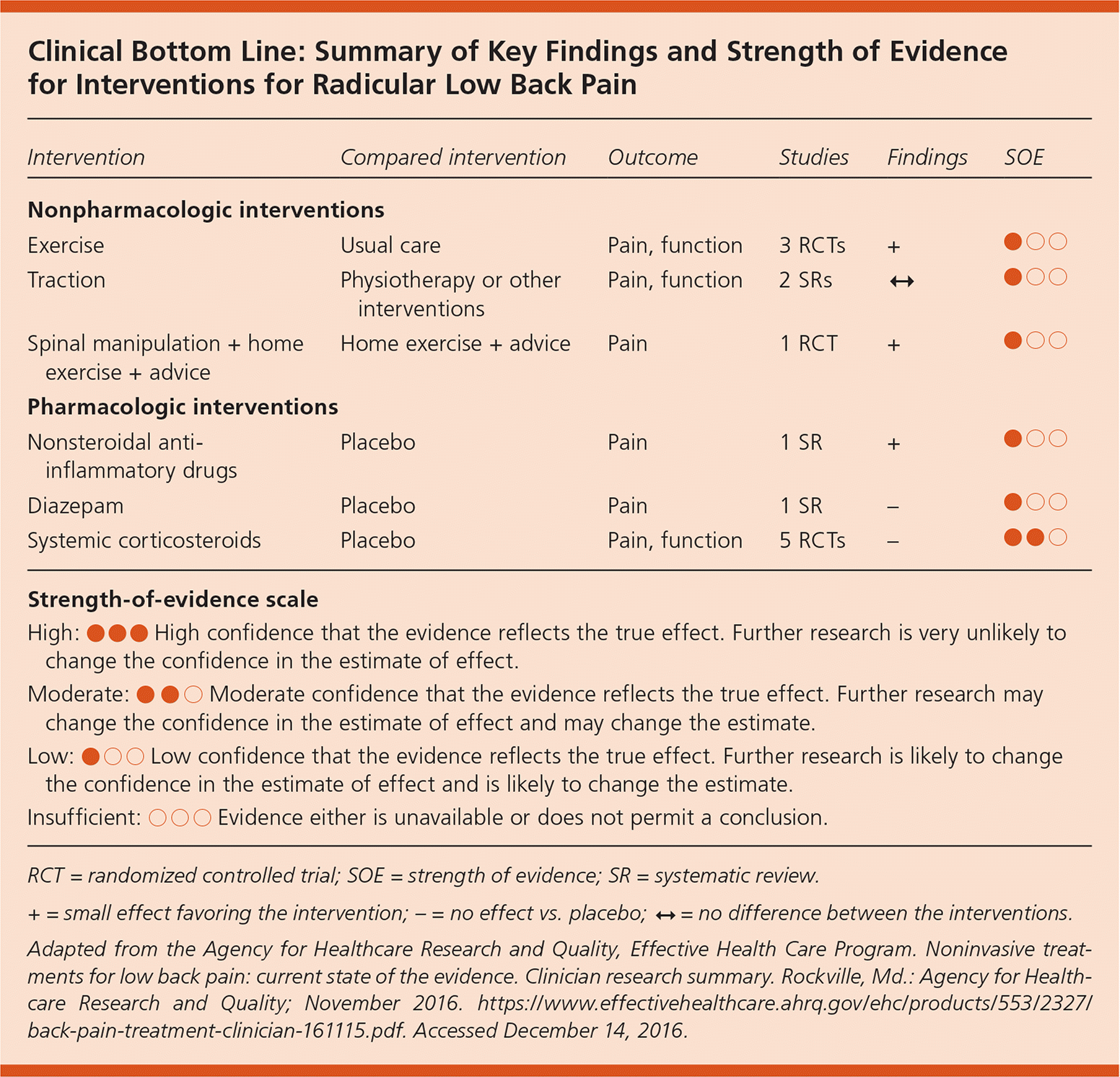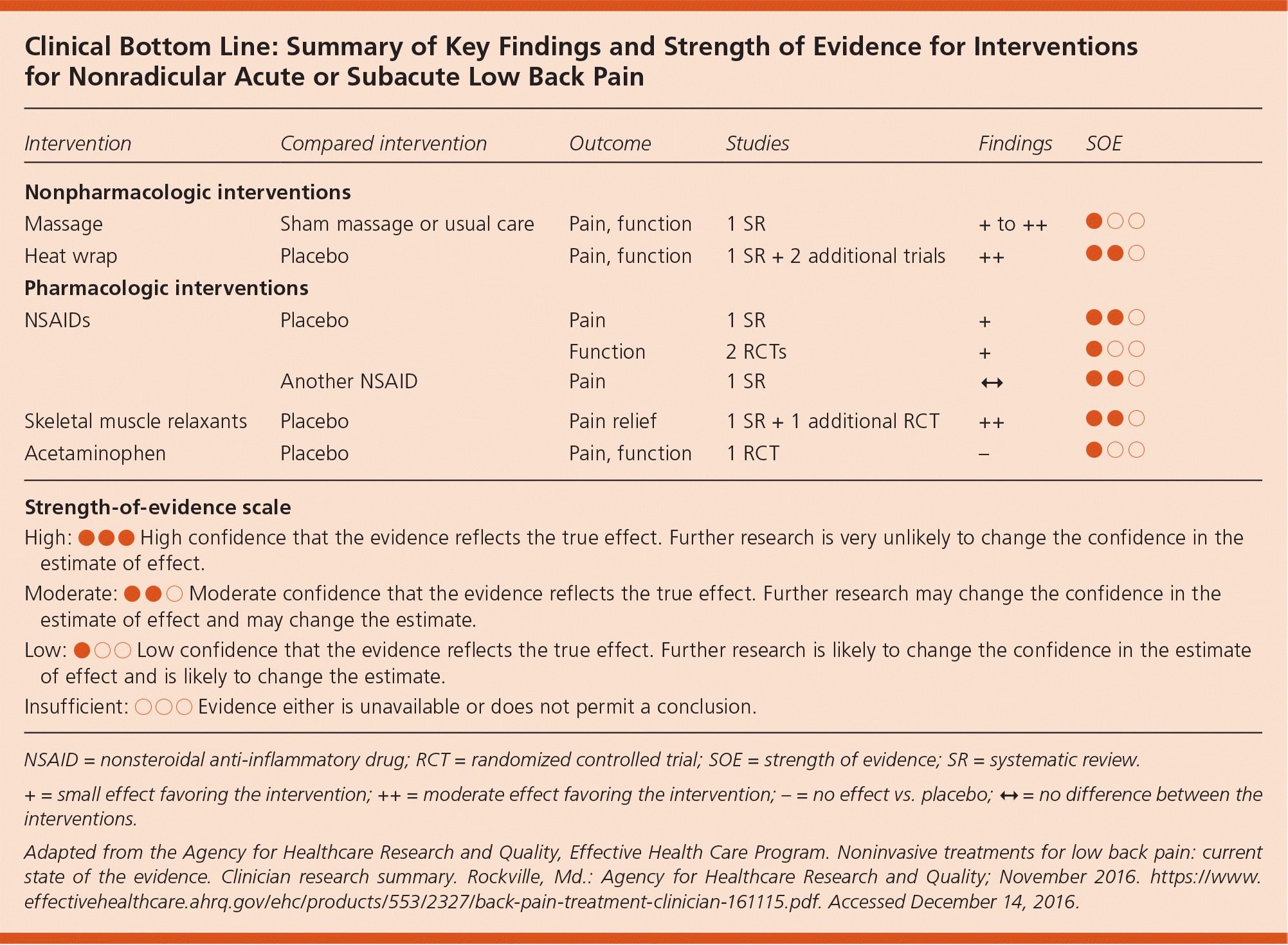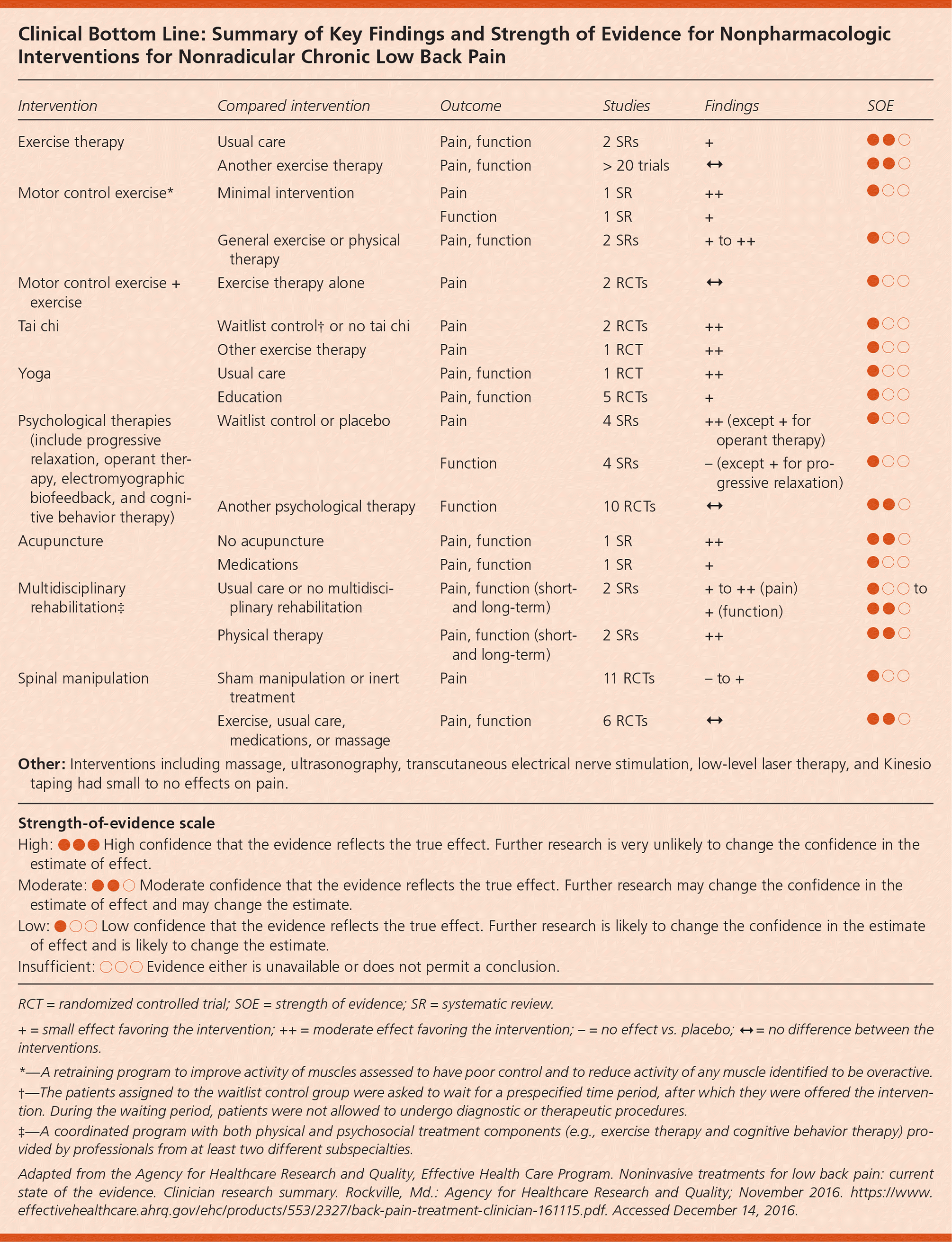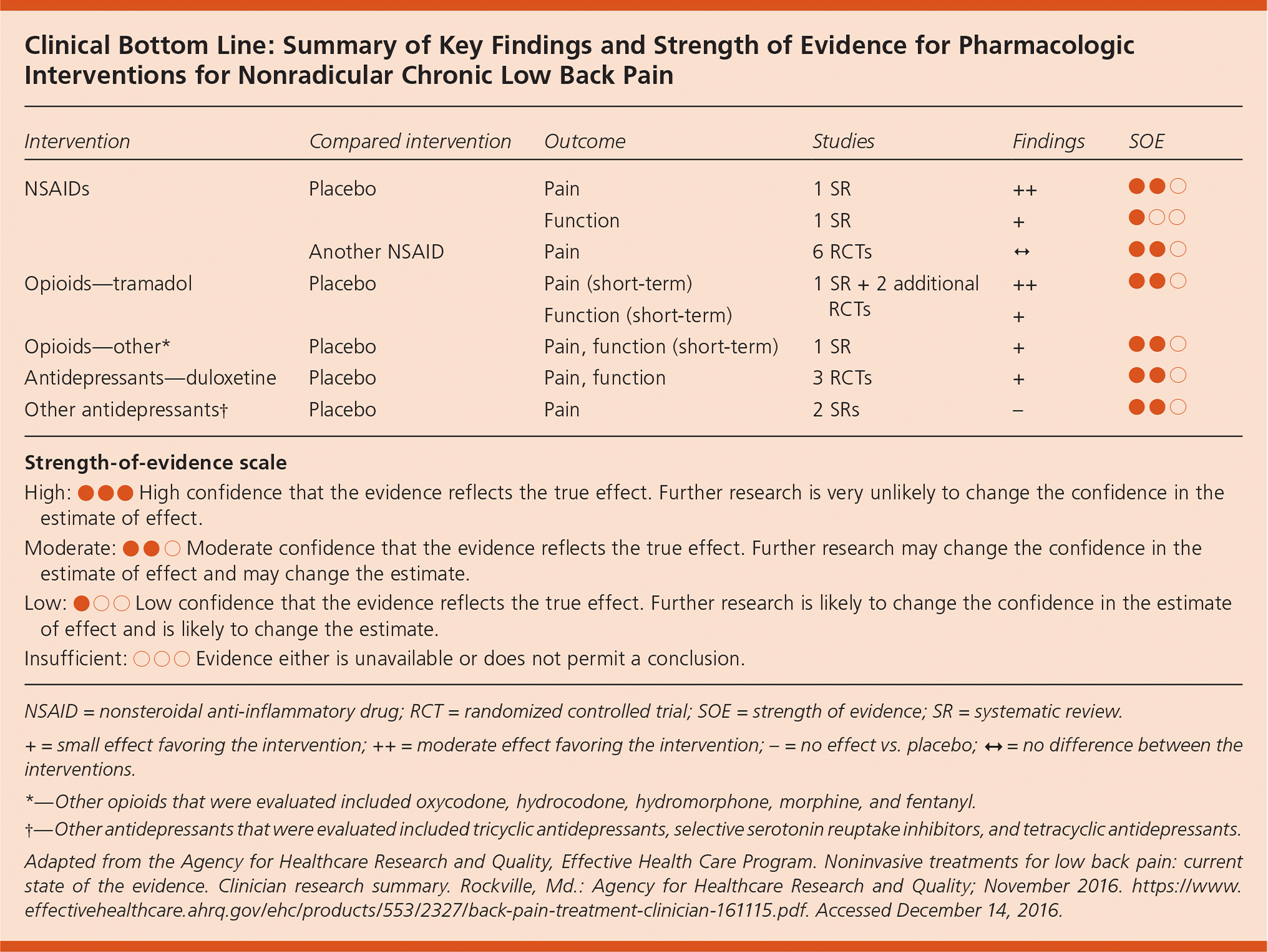
Am Fam Physician. 2017;96(5):324-327
Author disclosure: No relevant financial affiliations.
Key Clinical Issue
What are the benefits and harms of noninvasive treatments for acute, subacute, and chronic low back pain?
Evidence-Based Answer
Exercise, nonsteroidal anti-inflammatory drugs (NSAIDs), and spinal manipulation with home exercise and advice have small benefits for radicular low back pain. (Strength of Recommendation [SOR]: B, based on inconsistent or limited-quality patient-oriented evidence.) Massage, heat wrap, and NSAIDs improve pain and function for non-radicular acute and subacute low back pain, whereas skeletal muscle relaxants improve pain alone. (SOR: B, based on inconsistent or limited-quality patient-oriented evidence.) Multiple exercise programs improve nonradicular chronic low back pain, in addition to acupuncture and multidisciplinary rehabilitation. (SOR: A, based on consistent, good-quality patient-oriented evidence.) Psychological therapies improve chronic low back pain, but not function. (SOR: B, based on inconsistent or limited-quality patient-oriented evidence.) NSAIDs and antidepressants improve pain and function in nonradicular, chronic low back pain. Opioids show small, short-term improvements in pain and function. (SOR: A, based on consistent, good-quality patient-oriented evidence.)

| Intervention | Compared intervention | Outcome | Studies | Findings | SOE |
|---|---|---|---|---|---|
| Nonpharmacologic interventions | |||||
| Exercise | Usual care | Pain, function | 3 RCTs | + | ●○○ |
| Traction | Physiotherapy or other interventions | Pain, function | 2 SRs | ↔ | ●○○ |
| Spinal manipulation + home exercise + advice | Home exercise + advice | Pain | 1 RCT | + | ●○○ |
| Pharmacologic interventions | |||||
| Nonsteroidal anti-inflammatory drugs | Placebo | Pain | 1 SR | + | ●○○ |
| Diazepam | Placebo | Pain | 1 SR | – | ●○○ |
| Systemic corticosteroids | Placebo | Pain, function | 5 RCTs | – | ●●○ |

| Intervention | Compared intervention | Outcome | Studies | Findings | SOE |
|---|---|---|---|---|---|
| Nonpharmacologic interventions | |||||
| Massage | Sham massage or usual care | Pain, function | 1 SR | + to ++ | ●○○ |
| Heat wrap | Placebo | Pain, function | 1 SR + 2 additional trials | ++ | ●●○ |
| Pharmacologic interventions | |||||
| NSAIDs | Placebo | Pain | 1 SR | + | ●●○ |
| Function | 2 RCTs | + | ●○○ | ||
| Another NSAID | Pain | 1 SR | ↔ | ●●○ | |
| Skeletal muscle relaxants | Placebo | Pain relief | 1 SR + 1 additional RCT | ++ | ●●○ |
| Acetaminophen | Placebo | Pain, function | 1 RCT | – | ●○○ |

| Intervention | Compared intervention | Outcome | Studies | Findings | SOE |
|---|---|---|---|---|---|
| Exercise therapy | Usual care | Pain, function | 2 SRs | + | ●●○ |
| Another exercise therapy | Pain, function | > 20 trials | ↔ | ●●○ | |
| Motor control exercise* | Minimal intervention | Pain | 1 SR | ++ | ●●○ |
| Function | 1 SR | + | |||
| General exercise or physical therapy | Pain, function | 2 SRs | + to ++ | ●○○ | |
| Motor control exercise + exercise | Exercise therapy alone | Pain | 2 RCTs | ↔ | ●○○ |
| Tai chi | Waitlist control† or no tai chi | Pain | 2 RCTs | ++ | ●○○ |
| Other exercise therapy | Pain | 1 RCT | ++ | ●○○ | |
| Yoga | Usual care | Pain, function | 1 RCT | ++ | ●○○ |
| Education | Pain, function | 5 RCTs | + | ●○○ | |
| Psychological therapies (include progressive relaxation, operant therapy, electromyographic biofeedback, and cognitive behavior therapy) | Waitlist control or placebo | Pain | 4 SRs | ++ (except + for operant therapy) | ●○○ |
| Function | 4 SRs | – (except + for progressive relaxation) | ●○○ | ||
| Another psychological therapy | Function | 10 RCTs | ↔ | ●●○ | |
| Acupuncture | No acupuncture | Pain, function | 1 SR | ++ | ●●○ |
| Medications | Pain, function | 1 SR | + | ●○○ | |
| Multidisciplinary rehabilitation‡ | Usual care or no multidisciplinary rehabilitation | Pain, function (short- and long-term) | 2 SRs | + to ++ (pain) + (function) | ●○○ to ●●○ |
| Physical therapy | Pain, function (short- and long-term) | 2 SRs | ++ | ●●○ | |
| Spinal manipulation | Sham manipulation or inert treatment | Pain | 11 RCTs | – to + | ●○○ |
| Exercise, usual care, medications, or massage | Pain, function | 6 RCTs | ↔ | ●●○ | |
| Other: Interventions including massage, ultrasonography, transcutaneous electrical nerve stimulation, low-level laser therapy, and Kinesio taping had small to no effects on pain. | |||||

| Intervention | Compared intervention | Outcome | Studies | Findings | SOE |
|---|---|---|---|---|---|
| NSAIDs | Placebo | Pain | 1 SR | ++ | ●●○ |
| Function | 1 SR | + | ●○○ | ||
| Another NSAID | Pain | 6 RCTs | ↔ | ●●○ | |
| Opioids—tramadol | Placebo | Pain (short-term) | 1 SR + 2 additional RCTs | ++ | ●●○ |
| Function (short-term) | + | ||||
| Opioids—other* | Placebo | Pain, function (short-term) | 1 SR | + | ●●○ |
| Antidepressants—duloxetine | Placebo | Pain, function | 3 RCTs | + | ●●○ |
| Other antidepressants† | Placebo | Pain | 2 SRs | – | ●●○ |
Practice Pointers
Low back pain is one of the most common presenting problems in primary care, affecting 84% of adults at some point in their lives.1 At an estimated $87.6 billion in 2013, neck and back pain was the third most expensive condition in the United States behind diabetes mellitus and ischemic heart disease.2
This Agency for Healthcare Research and Quality (AHRQ) review identified 156 randomized controlled trials and systematic reviews of randomized controlled trials on the effectiveness of pharmacologic and noninvasive nonpharmacologic treatments for low back pain. Acute low back pain was defined as pain lasting less than four weeks, subacute as pain lasting four to 12 weeks, and chronic as pain lasting more than 12 weeks. Acute low back pain had generally favorable outcomes. The outcomes included changes in pain, function, or both. Benefits of treatments for pain were in the small to moderate range—less than a two-point change on a 10-point pain scale. Effects on function were included in studies less often than effects on pain, and showed even smaller benefits.
For chronic low back pain, exercise therapy, acupuncture, multidisciplinary rehabilitation, NSAIDs, opioids, and duloxetine all produced improvements in pain and function.1 Studies on opioids found only short-term effects.
The American Pain Society/American College of Physicians review showed evidence for moderate improvement in pain with cognitive behavior therapy and progressive relaxation.3 This AHRQ review found an improvement with psychological therapy, although this finding is based on low strength of evidence.1 Beneficial psychological therapies included progressive relaxation, electromyographic biofeedback, and operant therapy; 10 trials showed no difference among these therapies, and a systematic review showed no difference between psychological therapy and exercise therapy. There was insufficient evidence in two trials of cognitive behavior therapy because each study included only 34 patients, and one did not report treatment details.5
Although prior reviews of lower-quality studies concluded that acetaminophen was effective for acute back pain, the first placebo-controlled trial of acetaminophen found that it is not effective.6 The second new finding is that duloxetine is more effective than placebo for pain and function in patients with chronic low back pain, although the benefit is small and all trials were funded by the manufacturer.5 No studies compared duloxetine with tricyclic antidepressants or with other pharmacologic interventions for low back pain.
Back pain is a highly prevalent problem with no clear algorithmic treatment strategy. Based on this review, physicians may want to reassess what noninvasive treatments they are using for low back pain. When treating nonradicular acute and subacute back pain, physicians may consider muscle relaxants for patients who can tolerate the adverse effects because of their moderate effect size and moderate-quality evidence, and avoid acetaminophen because it has no benefits for these patients. Physicians can recommend exercise treatment options for patients with chronic low back pain that have shown a moderate benefit: motor control exercise, tai chi, and yoga. If available, physicians should also consider referring these patients for progressive relaxation, acupuncture, and exercise therapy.
editor's note: American Family Physician SOR ratings are different from the AHRQ Strength of Evidence (SOE) ratings.
